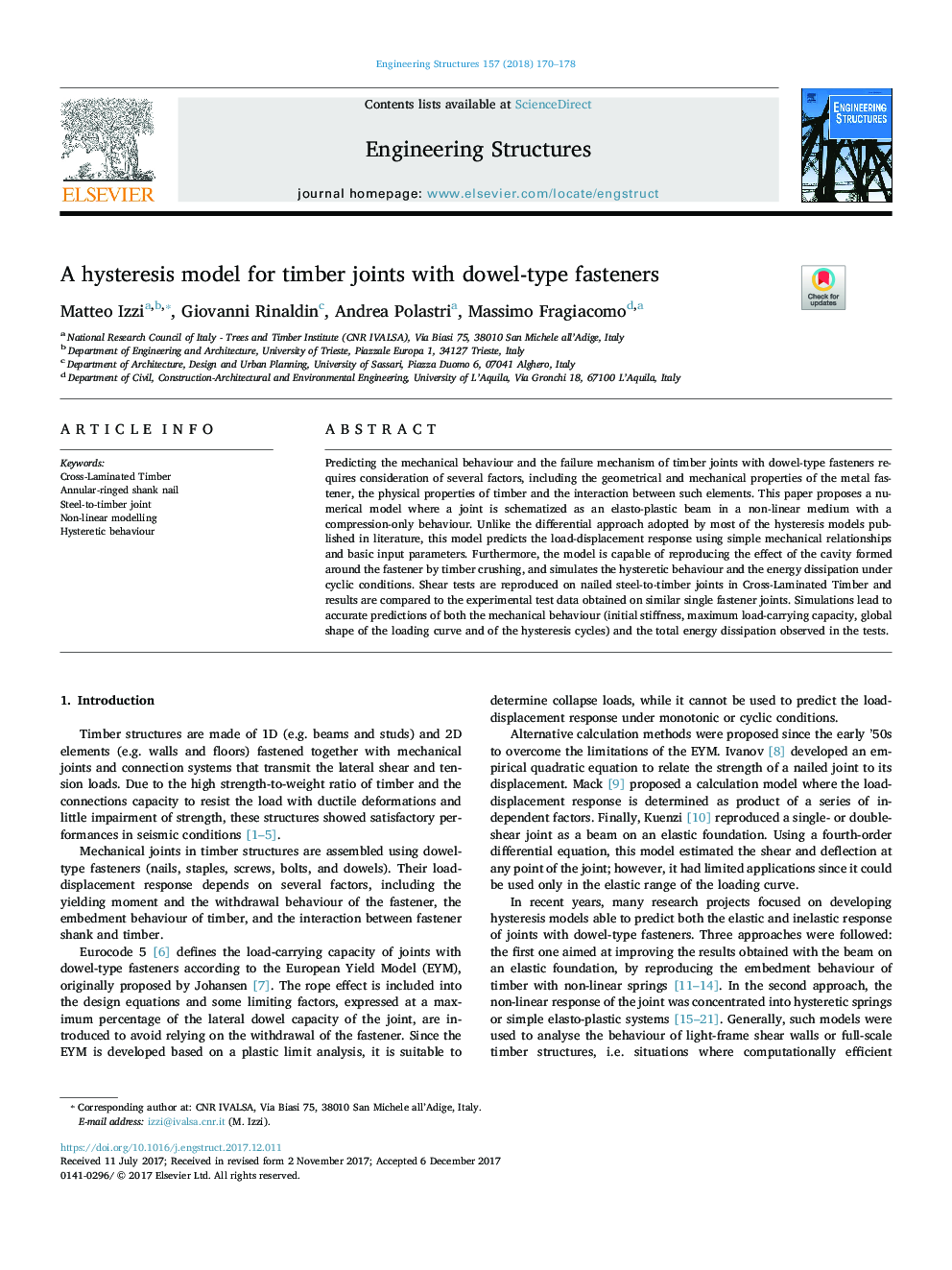| کد مقاله | کد نشریه | سال انتشار | مقاله انگلیسی | نسخه تمام متن |
|---|---|---|---|---|
| 6738722 | 1429070 | 2018 | 9 صفحه PDF | دانلود رایگان |
عنوان انگلیسی مقاله ISI
A hysteresis model for timber joints with dowel-type fasteners
ترجمه فارسی عنوان
یک مدل هیسترزیس برای مفاصل چوب با اتصال دهنده های دیلم
دانلود مقاله + سفارش ترجمه
دانلود مقاله ISI انگلیسی
رایگان برای ایرانیان
کلمات کلیدی
تخته چند لایه ناخن ساچمه ای حلقه ای، مشترک فولاد، مدل سازی غیر خطی، رفتار هیسترتیک،
ترجمه چکیده
پیش بینی رفتار مکانیکی و مکانیسم شکست مفاصل چوب با اتصال دهنده ها به نوعی نیاز به توجه چند عامل دارد، از جمله خواص هندسی و مکانیکی اتصال دهنده فلزی، خواص فیزیکی چوب و تعامل بین چنین عناصر. این مقاله یک مدل عددی پیشنهاد می کند که در آن یک مفصل به عنوان یک پرتو الاستیک پلاستیکی در یک محیط غیر خطی با یک رفتار فشرده سازی پوشیده شده است. بر خلاف رویکرد دیفرانسیل که توسط اکثر مدل های هیسترزی که در ادبیات منتشر شده است، پاسخ داده شده است، این مدل با استفاده از روابط مکانی ساده و پارامترهای ورودی اولیه، پاسخ بار جابجایی را پیش بینی می کند. علاوه بر این، مدل قادر است تا اثر حفره شکل گرفته در اطراف اتصال دهنده توسط چوب خرد کردن، و شبیه سازی رفتار هیسترتیک و انحلال انرژی در شرایط چرخه. تست برشی بر روی اتصالات فولادی به چوب در تخته چند لایه متصل می شود و نتایج با داده های آزمایشی آزمایش شده بر روی اتصالات تک اتصال دهنده مشابه مقایسه می شود. شبیه سازی منجر به پیش بینی دقیق رفتارهای مکانیکی (سختی اولیه، حداکثر ظرفیت حمل بار، شکل جهانی منحنی بارگیری و چرخه های هیسترزیزه) و انحلال انرژی کل مشاهده شده در آزمایشات می شود.
موضوعات مرتبط
مهندسی و علوم پایه
علوم زمین و سیارات
مهندسی ژئوتکنیک و زمین شناسی مهندسی
چکیده انگلیسی
Predicting the mechanical behaviour and the failure mechanism of timber joints with dowel-type fasteners requires consideration of several factors, including the geometrical and mechanical properties of the metal fastener, the physical properties of timber and the interaction between such elements. This paper proposes a numerical model where a joint is schematized as an elasto-plastic beam in a non-linear medium with a compression-only behaviour. Unlike the differential approach adopted by most of the hysteresis models published in literature, this model predicts the load-displacement response using simple mechanical relationships and basic input parameters. Furthermore, the model is capable of reproducing the effect of the cavity formed around the fastener by timber crushing, and simulates the hysteretic behaviour and the energy dissipation under cyclic conditions. Shear tests are reproduced on nailed steel-to-timber joints in Cross-Laminated Timber and results are compared to the experimental test data obtained on similar single fastener joints. Simulations lead to accurate predictions of both the mechanical behaviour (initial stiffness, maximum load-carrying capacity, global shape of the loading curve and of the hysteresis cycles) and the total energy dissipation observed in the tests.
ناشر
Database: Elsevier - ScienceDirect (ساینس دایرکت)
Journal: Engineering Structures - Volume 157, 15 February 2018, Pages 170-178
Journal: Engineering Structures - Volume 157, 15 February 2018, Pages 170-178
نویسندگان
Matteo Izzi, Giovanni Rinaldin, Andrea Polastri, Massimo Fragiacomo,
